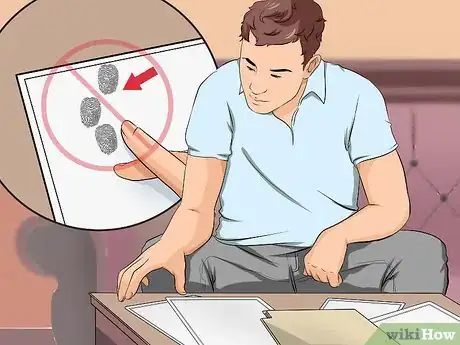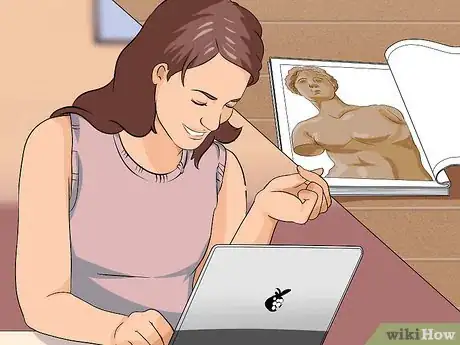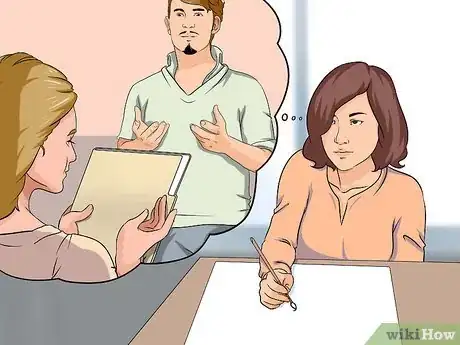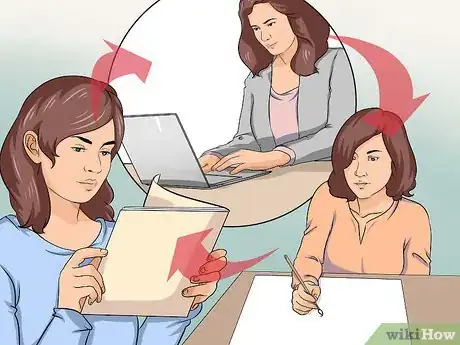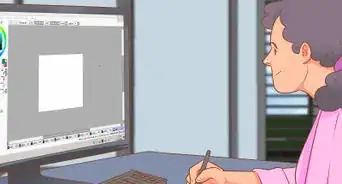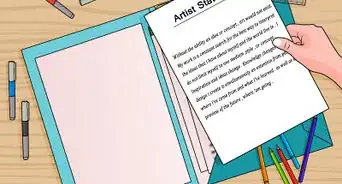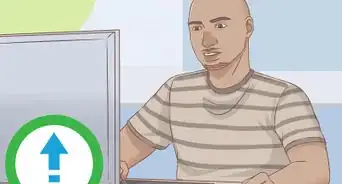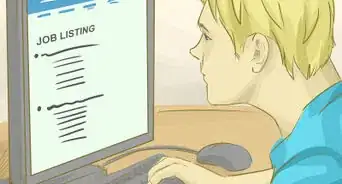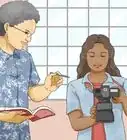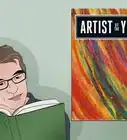This article was co-authored by Heather Gallagher. Heather Gallagher is a Photojournalist & Photographer based in Austin, Texas. She runs her own photography studio named "Heather Gallagher Photography" which was voted Austin's Best Family Photographer and top 3 Birth Photographers in 2017, 2018, and 2019. Heather specializes in family Photojournalism and has over 15 years of experience documenting individuals, families, and businesses all over the world. Her clients include Delta Airlines, Oracle, Texas Monthly, and her work has been featured in The Washington Post and The Austin American Statesman. She is a member of the International Association of Professional Birth Photographers (IAPBP).
wikiHow marks an article as reader-approved once it receives enough positive feedback. This article received 18 testimonials and 87% of readers who voted found it helpful, earning it our reader-approved status.
This article has been viewed 655,871 times.
Looking to showcase your work to an art gallery, to a university, or for an employer? An art portfolio is a great way to highlight all of your best pieces and show your abilities. A portfolio should speak for itself and combine professionalism, passion, personality, and a variety of pieces that have been inspired by you.[1] It will be your first impression and needs to stand out amongst other submitted portfolios. In your portfolio you want to show whoever you are catering to your talent, what makes you stand out from the rest, and why they should choose your portfolio over someone else's.
Steps
Compiling Pieces
-
1Look up the requirements for your portfolio. Every organization is different and so they may require different things within your portfolio or a different format for your portfolio. Your portfolio will also depend greatly on the type of study or career you are interested in pursuing. [2]
- For example, if you are applying to a film school or animation school, your portfolio will likely be digital and consist mostly of work that you have done within that field. On the other hand, if you are applying to an architecture school or to an art gallery you may have more sketches and drawings.
- Some institutions suggest only using about 10 to 20 pieces in your portfolio. If you have really strong pieces, fewer is better because the more pieces you have the more likely it is that the quality of the pieces will drop. [3]
- Always check what the organization expects before you begin piecing together your portfolio. You don't want to waste time creating a portfolio one way, and then have to redo it because it's not in the right format.
-
2Choose finished or unfinished pieces, based on the requirements for your portfolio. Many schools in the United States require that all of your work be finished, but some in other areas such as the United Kingdom want to see your process and development.
- Check the requirements for your portfolio before you do one or the other. If you are allowed to use unfinished pieces, do so. This reveals your skills, commitment, and depth of knowledge as well as gives context to the creation and thought process behind your work. A piece of art is often more than just the finished product, but greatly depends upon the process and experimentation of the piece.[4]
- Make sure all pieces, both finished and unfinished, are perfected. Remove any smudges, fingerprints, or defects that have been left on the piece.
Advertisement -
3Include observational drawings. These pieces prove that you are able to observe something in real life and create your own replica of it on paper. Observational drawings or paintings can make up a substantial part of your portfolio.
- The purpose of these drawings is to show those looking at your portfolio that you are able to record shape and form, detail, perspective, proportion, and surface qualities. [5]
- When drawing something from observation, aim for a sense of realism, without creating a rigid, mechanical copy of it. It may help to select a subject that's important to you, because you'll begin to think about the themes and motifs behind the drawings, rather than what's right in front of you.
-
4Highlight your best pieces. If you have been an artist for awhile you likely have an array of pieces, from the best, to really good, to mediocre, to poor. It may be tempting to choose your really good work along with your best work. However, these two need to be separated. You don't want to just showcase your really good work. You want to showcase only your best, the pieces that you are certain without a doubt show quality, ability, artistry, and creativity.[6]
- Be selective with your work and don't choose pieces just for the sake of variety. It's better to have solid pieces of art that vary less in medium or style than it is to have a lot of different mediums and styles but mediocre art.[7]
- If it's difficult to be unbiased or edit your own work, ask a friend or two what pieces are your best pieces. It could also be helpful to find a mentor in your own field. Look for someone with artistic talent who has been in your shoes before who can help you make difficult decisions like these. And, the good thing is you know you can trust their judgement because they have experience in artistry as well.
- Never choose art that is an imitation of someone else's art. Admissions offices and employers have seen thousands of portfolios and will likely be able to recognize if you have created artwork from a photograph or another piece of art. This also reveals your lack of creativity and inability to create art from real life.[8]
-
5Ask a friend to look over your art. After you have picked out a significant body of work, have a friend or mentors look over it, asking them to give feedback on the different pieces you have picked out.
- Some of your art may need to be redone or improved, so give yourself enough time before the portfolio needs to be submitted to improve your artwork.
- Build in time after you've chosen your pieces to reflect and come back to those pieces once you've been able to process. It's important to give yourself this time because you will be able to better evaluate your work and will come back to it with less bias.
- Sometimes friends can be biased towards your work as well, so it may be more beneficial to bring in someone that doesn't have a personal relationship with you. It may be easier to receive constructive criticism from them as well.
- Learn to take constructive criticism well and know that it's not an insult or derogatory comment, but given so that you can improve as an artist.
-
6Include supplemental articles, publications or awards. Some institutions will not ask for this, so once again, check the requirements for your portfolio. However, this can be helpful to show that your work has been recognized by others and that it has has previous exposure.
Assembling the Portfolio
-
1Use other portfolios as examples. The best way to begin a project like a portfolio is to find other successful portfolios online and use those as your guide. This doesn't mean copy the format, or follow the portfolio piece by piece, but it means to use it as a reference as you being making yours.
- Note how the artist organized his or her pieces. Pay attention to the style and design of the portfolio. Are your eyes drawn more to the design of the portfolio or are you drawn to the art? [9]
- If it feels intimidating or daunting to look at other portfolios, remember that only the best work is what is displayed. Art is made up of technical skill as well as creativity, so even if your technical skill isn't as advanced as those you see, your creativity can make up for it.
-
2Tailor your portfolio to the institution. A university and an art gallery may have very different ideas about what they would like to see in your portfolio or the design of your portfolio. It's important that as you begin assembling and organizing your portfolio that you keep the audience in mind.
- For example, if submitting your work to an art gallery, visit the gallery and make sure your work will fit in well in the gallery. Choose pieces, design, and organization of your portfolio that show you are familiar with the gallery and are aware of the art they carry.
- If applying to a university or job, always look up the requirements for the portfolio, but tailor your portfolio to the type of institution as well. You may be applying to a more prestigious art university that values technique and style, or maybe you are applying to a school that places a higher emphasis and creativity and experimentation. Keep these things in mind as you design and organize your portfolio.
-
3Organize your portfolio. Group pieces by style, subject, media, technique, etc. You want to make it as easy as possible for your reviewer to find the important information, or to determine if you are a good fit for their institution. By organizing your pieces you will give your reviewer an easy path to follow. You want your portfolio to tell a story.
- Group by medium. It's valuable to use different types of mediums in your portfolio to show you are well rounded and capable of doing different art forms. It can be helpful to group these mediums together so that your portfolio clearly shows your different abilities and how you've used each medium in your art. For example, you might group pastel art together, and then group charcoal drawings and pencil drawings together, and then you might group paintings together.
- Group by subject. Another way to group your artwork is by subject, which will likely combine different mediums, but will show your ability to accurately depict different things. For example, you may group by figure drawings, drawings of landscape, abstract art, etc.
- Group by technique. This is similar to grouping by medium, but instead you are focusing on your range of abilities to use not just paper, but digital media, photography, web design, animation, etc.
- Use a scrapbook or portfolio binder found at any art or craft store to organize and present your artwork.
-
4Keep it simple. As an artist, you may be tempted to have a really extravagant, creative portfolio. While it's great if your pieces are this way, the portfolio that holds and displays your pieces should be professional, organized, and simple.
- The purpose of this is because you don't want a very busy portfolio to distract your viewer from the artwork. You want the focus to be on your artwork, because that's what you are really trying to showcase.
- Space out your portfolio. Don't have too many pieces on one page and don't go overboard with the information you include.
-
5Stand out, but don't be overzealous. With an industry that is so competitive, it's important for your work to stand out.[10] You don't want to be grouped in with the hundreds of people who have also submitted their portfolio, so try to create a portfolio that highlights your pieces so well in a creative way that the reviewers can't help but notice.
- Be careful about overdoing it, though. If your attempts to stand out lead you to creating something corny, or trying to be humorous but failing, you may go unnoticed, or be noticed but in a negative way.
- The benefit of a portfolio is that you aren't just a name on a piece of paper like a resume. Your work really speaks to who you are and it is easier for an employer to grow attached to the creative impressions in your portfolio than a written set of job skills.
- Don't overthink your portfolio. Once you have completed it, have a mentor give you feedback, go over it a few times to make sure it is organized well, and clear of any mistakes, and then leave it. By continually trying to edit and improve your portfolio, you run the risk of changing it to "make it stand out" that may lead to a decrease in the professionalism of your portfolio.
-
6Create a virtual portfolio. While it's handy to have your portfolio in a hard copy, having a virtual copy of your portfolio will be helpful when submitting your portfolio online, which is likely what you'll have to do for most applications.
- Photograph or scan your artwork. After you have chosen the pieces for your portfolio, use a good quality camera to take pictures of your art, or ask a professional to take the pictures. Make sure the pictures are clear and high quality so that when viewed online the resolution is good. Choose a setting with excellent lighting and no glare, and never use a flash. When scanning artwork, make sure there are no wrinkles on the page and that it lies flat on the scanner so the picture comes out exactly like the hard copy.
- Input these pictures into Indesign or another program that allows you to create a clean cut portfolio that is easy to continually edit.
- This not only provides you with a digital copy to use online, but also serves as a backup in case your hard copy is lost or destroyed.
Preparing to Show Your Portfolio
-
1Practice presenting your portfolio. If you have the opportunity to show your portfolio in person, it's important to practice going through it, knowing what you will say for each piece and how you can effectively communicate why you think your work stands out and is valuable.
- Once you've practiced it on your own a few times, present it to a friend or mentor who can give you feedback on your presentation and how you are communicating your art.
- Once again, your art should speak for itself. When presenting a portfolio you shouldn't have to go in depth on every piece to explain it, it should explain itself for the most part. However, there may be pieces that were inspired by an event in your life or mean something to you. Use those as an opportunity to show your creativity and passion behind your work.
-
2Gain feedback once you have completed your portfolio. Ask a mentor or friend to look over your completed portfolio, making notes on the organization, themes, format, and final work you have chosen.
- You can also attend a portfolio review. There are National Portfolio days in which college admissions counselors will come to high schools and college campus events to review students' artwork. Seek feedback on how you can improve your portfolio, and use this as a trial run to prepare you for officially presenting your portfolio.
- Little details matter too. If you have text in your portfolio, always check for grammar mistakes. It can be easy to focus on just the art, but employers and admissions counselors want to see that you have reviewed all of your work and that you take this submission seriously. You don't want to spend all your time making a fantastic portfolio that an employer or admissions counselor loves, and then lose all chance of being chosen because you misspelled the name of the institution or used incorrect grammar.
-
3Update your portfolio on a regular basis. Even if you have already submitted your portfolio to several institutions, always be ready to update and revise your portfolio with new and better work.[11] Save time doing this as you go, so that you won't have to do a major project of revision the next time you submit your portfolio.
- This will keep your work relevant, and up to date with your abilities and awards.
- Continually ask yourself, "Am I in this?" Your art should reflect yourself and your passions so as you update and revise your portfolio make sure it still conveys the story you hope to communicate.
Expert Q&A
-
QuestionHow do I make a portfolio as a beginner?
 Heather GallagherHeather Gallagher is a Photojournalist & Photographer based in Austin, Texas. She runs her own photography studio named "Heather Gallagher Photography" which was voted Austin's Best Family Photographer and top 3 Birth Photographers in 2017, 2018, and 2019. Heather specializes in family Photojournalism and has over 15 years of experience documenting individuals, families, and businesses all over the world. Her clients include Delta Airlines, Oracle, Texas Monthly, and her work has been featured in The Washington Post and The Austin American Statesman. She is a member of the International Association of Professional Birth Photographers (IAPBP).
Heather GallagherHeather Gallagher is a Photojournalist & Photographer based in Austin, Texas. She runs her own photography studio named "Heather Gallagher Photography" which was voted Austin's Best Family Photographer and top 3 Birth Photographers in 2017, 2018, and 2019. Heather specializes in family Photojournalism and has over 15 years of experience documenting individuals, families, and businesses all over the world. Her clients include Delta Airlines, Oracle, Texas Monthly, and her work has been featured in The Washington Post and The Austin American Statesman. She is a member of the International Association of Professional Birth Photographers (IAPBP).
Professional Photojournalist & Photographer Try to create as much content as possible. Play around with different styles and see what really speaks to you. As you figure out your strong suits, you will develop a signature style, whether it's the fact that you shoot with only natural light or that you focus on a particular subject or theme. You want to have a cohesive thread that runs through your work that makes it recognizable as yours.
Try to create as much content as possible. Play around with different styles and see what really speaks to you. As you figure out your strong suits, you will develop a signature style, whether it's the fact that you shoot with only natural light or that you focus on a particular subject or theme. You want to have a cohesive thread that runs through your work that makes it recognizable as yours. -
QuestionMy paintings are large oil paintings. How do I include them in my portfolio?
 Community AnswerTake a photo or have someone take pictures of each piece. Have the pictures printed then add them to the portfolio.
Community AnswerTake a photo or have someone take pictures of each piece. Have the pictures printed then add them to the portfolio. -
QuestionShould I sign my name in the front on artwork for art school portfolios?
 Community AnswerYou can if you want but it is not essential. If your work is on multiple pages, get a presentation folder and perhaps create a title page with your full name and signature. But if your work is on a canvas, don't sign the front if it were for school -- instead, you would probably sign the back. Talk to your art teacher about the preferences in class.
Community AnswerYou can if you want but it is not essential. If your work is on multiple pages, get a presentation folder and perhaps create a title page with your full name and signature. But if your work is on a canvas, don't sign the front if it were for school -- instead, you would probably sign the back. Talk to your art teacher about the preferences in class.
References
- ↑ Heather Gallagher. Professional Photojournalist & Photographer. Expert Interview. 8 April 2020.
- ↑ http://www.studentartguide.com/articles/how-to-make-an-art-portfolio-for-college-or-university
- ↑ http://www.studentartguide.com/articles/how-to-make-an-art-portfolio-for-college-or-university
- ↑ http://www.studentartguide.com/articles/how-to-make-an-art-portfolio-for-college-or-university
- ↑ http://www.studentartguide.com/articles/how-to-make-an-art-portfolio-for-college-or-university
- ↑ Heather Gallagher. Professional Photojournalist & Photographer. Expert Interview. 8 April 2020.
- ↑ http://www.studentartguide.com/articles/how-to-make-an-art-portfolio-for-college-or-university
- ↑ http://www.studentartguide.com/articles/how-to-make-an-art-portfolio-for-college-or-university
- ↑ http://www.studentartguide.com/articles/how-to-make-an-art-portfolio-for-college-or-university
About This Article
To make a digital art portfolio, start by taking high-resolution photos of all of your artwork, making sure there aren't any glares or shadows. You can also scan your artwork depending on the medium you work with. Then, upload the images of your artwork onto a computer, and assemble them in a digital portfolio using Indesign or another program. Or, you can upload your artwork onto your own website and use that as your portfolio. To learn how to make a hard copy portfolio, read on!


